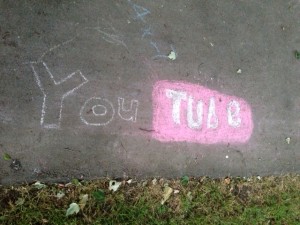Some children in my neighbourhood drew some pictures that reminded me of the class, and how much media is present in today’s
 childrens’ lives.
childrens’ lives.
Author: sambee
Gaming, Learning as a Process
Blog post #2
My sister’s fiancé is a serious, serious gamer. He has friends he socializes with more online, in Ventrilo, than he does face-to-face, and when he does see his friends in person it is frequently to play games beside each other in LAN parties. He becomes so engrossed in these alternate realities that he even forgets to eat. Admittedly, I have tsk-tsked and haughtily wagged my finger at his hobby, wondering why he doesn’t do something more worthwhile. After reading this article, I began to question what I mean by “worthwhile”. Why do I consider the hours he spends on games to be a waste of time, especially after this article outlines all the different kinds of learning that occurs in gaming. I then asked my husband what he thought about it, and we talked about how he enjoys games, but feels like it’s a waste of time because he has nothing tangible to show for all the hours he put into this virtual reality. At the end of the day, there’s no short story written, or pictures from a day outside, or a drawing in a sketchbook. Why did he and I both consider learning, in which there is no concrete end-product, a waste of time?
In my practicum school, the teachers were frequently frustrated because the students in the school were overall very mark-hungry. Many of the students in the school only cared about getting an “A”, but showed complete disregard for the learning that needed to happen in the process. I was a lot like these students growing up. I worried and stressed about my report card and so did my parents. I could work hard in a class and only manage to get a “C”, but that “C” would not be as highly regarded to my parents as a class in which I put in very little effort to get an “A”. To them and to me, the end product was more important that the mistakes and successes I encountered along the way. A quote in this article that resonated with me was “How can we make learning in and out of school, with or without using games, more game-like in the sense of using the sorts of learning principles that young people see in good games everyday, when and if they are playing these games reflectively and strategically?” (37). I think this question is really important because schools do need to make learning more game-like, in emphasizing that learning is fun and the end result not as important as the process.
Response to Frey and Fisher
When I was on my practicum, I attended a pro-d day presentation on visual thinking strategies that showed me how effective still images can be in helping students learn what it means to provide an analysis. The presenter, a woman from an art gallery, showed us a very complicated and busy image. The room full of teachers were asked only three questions: “What’s going on in this picture?”, “What do you see that makes you say that?”, “What more can we find?”. After each comment, the presenter would repeat back comments neutrally while pointing to the area of the image being described, and linking the comment to other comments. I was skeptical at first, but in the end I was extremely surprised at how quickly everyone moved towards making analytical comments. Approaching the image with a sense of wonder ended up being a pretty unintimidating way to approach a text, and having the presenter, a knowledgeable art gallery employee, repeat back comments created a feeling of being understood and validated. I later tried this same strategy with my students and I found it to be equally as effective.
While I enjoyed the article by Frey and Fisher and while I was happy to see that they found success with using graphic novels with grade 9 students, I wondered if the students could have further benefitted from the visual thinking strategies I learned about. I love the use of creative projects in the classroom, but I think that using visual media lends itself well to helping students also build analytical skills and thus, academic writing and speaking skills. Then again, I also wonder if I am wrong and there’s plenty of analytical thinking happening that the article cannot sufficiently showcase because, oddly enough, there are no images in this article about graphic novels and anime.
My last thought when reading this article was about the quote “A barrier for school use [of graphic novels] is the predominance of violence and sexual images in many graphic novels” (20). What is it about imagery that makes it so much more unacceptable than sex described in a novel, or murders in a play? Many of Shakespeare’s plays have violence and sex, yet it is perfectly acceptable to read in school. Would a graphic novel of Hamlet be acceptable to read? If so, would it be because Shakespeare wrote it? If not, would it be because it’s worse to see the violence than to read it?